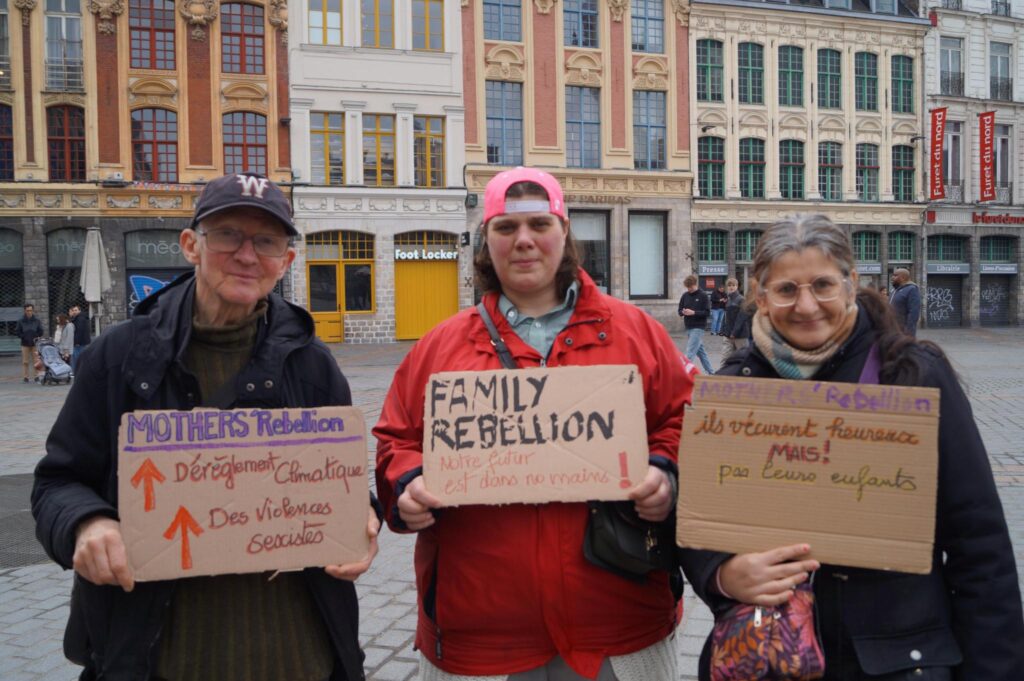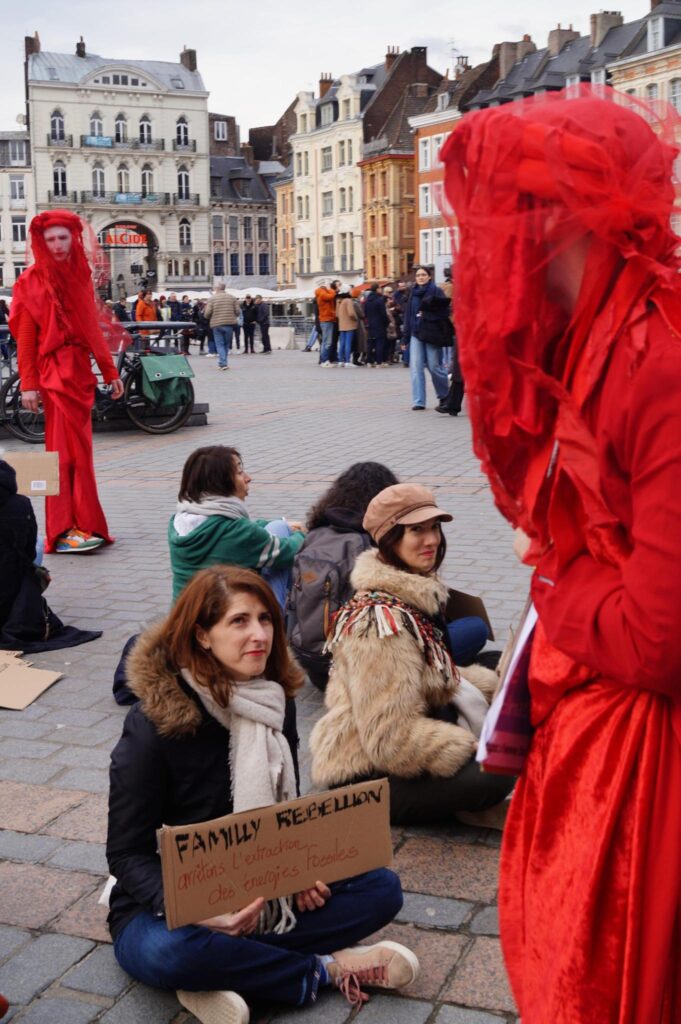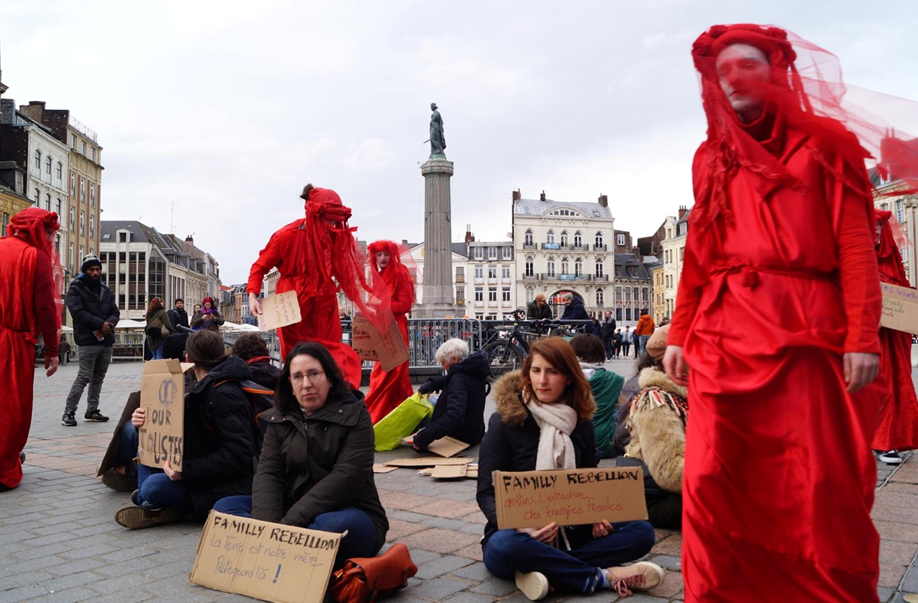An International Center on Nonviolent Conflict (ICNC) blog on the people and power of civil resistance
By Gaia Martino
One of the first things that struck me when I joined a local group of Extinction Rebellion (XR) France was that there were far fewer students than I had expected. Instead, many elderly people, full-time professionals and working moms participated in the group as well. A friend of mine based in Leiden even told me that in the Netherlands the movement organized blockades of some of the country’s main highways with significant participation of elderly people.

FamilyRebellion, Lille, France, March 2024. Credit: XR Lille/anonymous with permission.
This was made possible by the fact that XR is a modern-day example of a movement that walks the walk and doesn’t just talk the talk—in other words, XR does its best to live up to its values. For a movement to call itself inclusive and horizontal is extremely easy; for it to actually work towards those values, constantly questioning its actions, is way harder. By embodying the societal values it espouses, XR practices a form of political prefiguration. This is an essential ingredient of transforming people’s minds and hearts for long-lasting change. Prefiguration allows us activists to go beyond single campaigns to build a culture that opposes hatred, domination and oppression.
Yet there is a paradox in climate justice today. It is that we must be highly focused on local, short-term campaigns to even have a chance of achieving our goals, which are usually at the global scale (curb global warming, put an end to rising sea levels, etc.). Having participated in an XR local chapter in Lille, France for five months, I wrote this post to explore three characteristics of XR more broadly, which I believe can help environmental movements navigate this great paradox. These aspects are: operating via self-organization and dispersion for improved relevance and effectiveness; embracing creative nonviolent action for more inclusivity; and prioritizing a care culture for stronger resilience and coherence.
Self-organization and dispersion

The organizational model of XR worldwide relies on small working groups, which sociologists call sociocracy. In short, self-organization is when anyone is able to organize autonomously to address the problem that is the most urgent for them and to act with the name and spirit of XR, as long as the action is coherent with the principles and values of the network.
This way, power is decentralized or, even better, dispersed. There’s neither a central or local authority. The choice to apply this system is mainly driven by strategic choice: anyone can execute an action and claim it as an XR one, the 10 principles working as a shield from agents provocateurs. Without the burdens of a traditional concentrated movement structure, actions can take place frequently in many places at one time, even if there is a lot of turnover in local groups.
Dispersion and a structure based on local groups also enable XR to target issues that are the closest to local populations and to develop achievable goals that only require actions from or seek the attention of local actors, who are typically more accessible and responsive than major international corporations or governments. In the next section, I describe an XR Lille action in which I participated to further illustrate this point as well as to explore a second defining characteristic of XR.
Creative nonviolent action and inclusivity

Last March, elderly people, women and children joined the FamilyRebellion sit-in that XR Lille had organized in the city center so that families could protest fossil fuels. These families felt that money spent on fossil fuels is contrary to what an investment should do: brighten young people’s future.
We sat in a central plaza and invited passersby to join us, smiling and politely explaining the reasons for our action: to connect with local families, create a welcome space for dissent about climate injustice to be voiced and thus grow movement participation. Some of us were dressed up symbolically as Red Rebels and we were so unthreatening that many people became curious enough to approach us. The police actually let us do our thing, despite the fact that we had not declared the action—some officers even came and spoke to us about XR.
Even if the action did not receive much media coverage, many people stopped to chat and a few families and elderly people sat in the circle with us or took photos with the signs we had prepared and posted them on their social media accounts. Signs said, for example: “Mothers’ Rebellion. Climate deregulation is up. Sexual violence is up. […] Mothers’ Rebellion. We believe in it. We fight for it” and “Let’s stop fossil energy extraction.” The connections made with people were real. Our goals were achieved in this sense, not to mention that families passing by came away from the interaction with a positive image of climate activists.
Part of inclusivity for XR more broadly is embracing nonviolent action as their method, and in particular creative civil disobedience: this aims to help the group gain in popularity and public legitimacy, which are more important today than ever. In many world regions, governments do nothing to address ongoing murders of environmental activists for their activism, and France’s neighboring governments are increasingly seeking to delegitimize activists and criminalize nonviolent actions for climate justice.
On a more personal note, XR’s commitment to inclusivity is what made it possible for me—an Italian exchange student and non-native French speaker—to take part in local chapter meetings and actions. The other members, most of whom are French, always do their best to communicate and to understand what I say, inviting me to social gatherings and giving value to my not-so-well-shaped sentences. Besides, I was not the only minority in the group: XR Lille enjoyed the participation of many non-male, queer and elderly individuals as well.
La culture régénératrice and political prefiguration

In order to accomplish its goals, XR advocates for radical change, a kind of material change that would be impossible without a cultural revolution. This means reshaping people’s beliefs and behaviors concerning care, self-care, care of others and of the planet in a logic that opposes hegemony in all its forms. Most important, the care-centered perspective that XR embraces creates space for intersectionality and horizontality.
La culture régénératrice—care culture—is about safeguarding activists’ mental health as part of the collective well-being, but it means much more than this too. Care culture enables a movement to safeguard against forms of domination related to skin color, gender, age, culture… One concrete way XR does this is by organizing seminars and workshops about cross-cutting themes like nonviolent communication and how to use creativity in nonviolent actions. Another example from XR Lille is that they have a choir, which serves as an informal, accessible space for activists to make music as a collective and to bond.
This isn’t to be taken for granted: care-centered movements create space for ideas to circulate and compel activists to de- and re-construct their identities. Ultimately, it’s these micro-social changes in the way we relate to ourselves and to power that plant the seeds for societal change.
These core characteristics of XR are all part of a strategy of political prefiguration. As a young female foreigner, I witnessed first-hand XR’s efforts to be as inclusive as possible and to adopt a care culture coherent with the group’s vision for change. As a participant of many organizational meetings, I also witnessed first-hand XR’s successful efforts to grant organizing autonomy to local chapters. Nonviolent action, inclusivity, autonomy and care culture are all coherent with XR’s design to create a paradigm shift in how people organize for environmental justice. To obtain a culture that will heal the planet as well as society, we must rise above the paradox that climate action must simultaneously be local and transcend the local.
And for this, everyone must believe they can play a small part in shaping, setting up and enacting change.

Gaia Martino is a sociology student at the University of Milan Bicocca and spent a semester at the European School of Political Science at the Catholic University of Lille. Gaia has participated in a number of research groups, including LINK Coordinamento Universitario, and has taken part in several campaigns for the right to education and environmental and social rights in Milan, with the groups End Fossil and Tende in Piazza.
This blog was posted on July 23, 2024 at The International Center on Nonviolent Conflict (ICNC).
